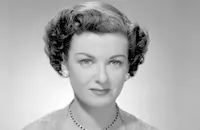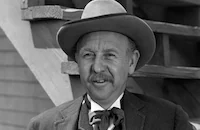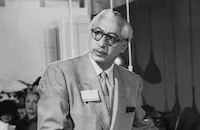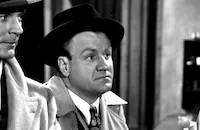Hollow Triumph

Brief Synopsis
Cast & Crew
Steve Sekely
Paul Henreid
Joan Bennett
Eduard Franz
Leslie Brooks
John Qualen
Film Details
Technical Specs

Synopsis
After serving a jail sentence, gangster John Muller is offered a job by his parole officer at the Meiklejohn company in Los Angeles. Before he settles down, John is anxious to perform one more heist, and convinces his former gang to help him rob a gambling house owned by rival mobster Rocky Stansyck. While escaping with the cash, gang members Big Boy and Rosie are caught by Stansyck, but John and his friend Marcy escape. Marcy, who is terrified that Stansyck's men will hunt him down and kill him, moves to Mexico, while John accepts the job at Meiklejohn. Later John's brother Frederick tells him that Marcy was murdered in Mexico City and that Stansyck's men have tracked John to Los Angeles.
One day while running an office errand, John is mistaken for a psychologist named Victor Bartok, who, except for a scar on his face, could easily pass as John's double. John immediately visits Bartok's office, where his secretary, Evelyn Hahn, greets him with a passionate kiss, mistaking him for Bartok. After realizing her error, Evelyn, who has given up on finding true love, agrees to go out with John, even though she is seeing Bartok. When John returns to the office, he gets into a fight with his superior over his absence, and is fired. In the next few weeks, while he is dating Evelyn, John steals one of Bartok's canceled checks from the office to practice forging his signature, rehearses Bartok's voice from taped sessions with his patients, and studies their case histories. Finally, John tells Evelyn he is moving to Paris and plots Bartok's murder. After noticing that Bartok parks his car at the Clover Garage when he goes to the opera, John gets a job as a garage attendant. He then takes a photograph of Bartok in order to match the scar on his face. The negative is developed backward, however, and John mistakenly cuts into the wrong cheek.
The weeks pass as the scar forms, and one night, after Bartok returns from the opera, John strangles him in his car before discovering that he has scarred the wrong side of his face. The following night, John meets Bartok's unsuspecting wife Virginia when he and Evelyn go out to a gambling club Bartok frequented called Maxwell's. Meanwhile, John's brother Freddie goes looking for John at Clover Garage and is told that during his last night on the job, John disappeared for four hours after bringing Bartok his car. When Freddie sees John emerge from Bartok's inner office, he blurts out in front of Evelyn that "Bartok" is his brother. John, however, maintains his impersonation, and Freddie is fooled into thinking he really is the doctor. Freddie tells "Bartok" that the man who was after his brother was arrested on an income tax charge and will soon be deported.
Deducing John's situation, a distraught Evelyn runs home and buys a steamship ticket to Honolulu. John follows her and they argue. After hitting Evelyn, John promises to renew her faith in love and join her on the boat. Later as Evelyn waits onboard, John is attacked by two thugs from Maxwell's, who accuse him of welching on his gambling debt. Although John insists he is not Bartok, the men shoot him when he tries to escape. As John limps toward the departing boat and collapses on the dock, Evelyn tearfully goes inside, believing John has deserted her.

Director
Steve Sekely
Cast

Paul Henreid

Joan Bennett

Eduard Franz

Leslie Brooks

John Qualen
Mabel Paige
Herbert Rudley

Charles Arnt
George Chandler
Sid Tomack
Alvin Hammer
Ann Staunton
Paul Burns
Charles Trowbridge
Morgan Farley
Mack Williams
Franklyn Farnum
Joel Friedkin
Phillip Morris
Renny Mcevoy
Tom Stevenson

Benny Rubin
Jerry Marlowe
Constance Purdy
Cay Forester
Carmencita Johnson

Lucien Littlefield
Norma Varden
Catherine Doucet
Victor Jones
Babe London
Flo Wix
Lulu Mae Bohrman
Cy Ring
Sam Finn
Tony Horton
Joaquin Elizondo

Lyle Latell
Robert Bice
Dave Schilling
Nolan Leary
Robert Ben Ali

Henry Brandon

Bud Wolfe
Tom Browne Henry

Jack Webb
Dick Wessell
Cliff Clark
Eddie Dunn
Steve Carruthers
Ray Bennett
Sayre Dearing
Dulcie Day
Felice Ingersoll
Joan Myles
Vera Marshe
Jeanne Blackford
Crew
Fred Allen
John Alton
Leon S. Becker
Frank Durlauf
Emmett Emerson
Bryan Foy
Irving Friedman
Daniel Fuchs
Paul Henreid
Edward Ilou
Sol Kaplan
Armor Marlowe
Hugh Mcdowell
Kay Nelson
Charles Previn
Merle Reeves
Joan St. Oegger
Clarence Steenson
Stewart Stern
George J. Teague
James T. Vaughn
Ern Westmore
Frank Westmore

Videos
Movie Clip




Hosted Intro
Film Details
Technical Specs

Articles
Hollow Triumph (aka The Scar)
-- Paul Henreid, Hollow Triumph
Actor Paul Henreid had his first shot at production with the 1948 film noir Hollow Triumph whose fate mirrored its title. Though the picture is a favorite with fans of the genre, particularly because of John Alton's atmospheric cinematography, it ended up a financial failure through no fault of Henreid's.
Like many actors in post-World War II Hollywood, Henreid had been chafing under the restrictions of the studio system. After his second film with Bette Davis, Deception (1946), he had left the studio to freelance. The popular actor found himself courted by MGM, where he had made his first post-Warner's film, Song of Love (1947). Although that turgid biography of the Schumanns (with Katharine Hepburn as Henreid's wife) had been a critical and box-office disappointment, studio executives felt they could profit from his presence on the lot. When Henreid refused the encumbrance of another long-term studio contract, it triggered a rift between the actor and his agent, MCA's Lew Wasserman.
Instead, he accepted an offer from Eagle-Lion, the recently formed U.S. arm of English producer J. Arthur Rank, to produce and star in a movie. With financing from railroad magnate Robert Young, he put together a production based on actor-novelist Murray Forbes' Hollow Triumph, the story of a criminal on the run who scars himself to take the place of a prominent psychiatrist, not realizing his new identity may provide more problems than those he had been fleeing in his own life. Henreid had heard of the novel from Hungarian director Steve Sekely, who had been languishing in B movies since his arrival in the U.S. in 1939. In gratitude, he hired Sekely to direct the film.
To write the adaptation, Henreid approached Daniel Fuchs, a once-promising novelist who had fallen on hard times since coming to Hollywood. Henreid had been impressed with Fuchs' work on Warners' Between Two Worlds (1944), but even though he was broke, the writer initially turned down the offer, claiming he didn't know how to write about gangsters. In truth, Fuchs had dealt with organized crime in his 1937 novel Low Company, which he had adapted to the screen in 1947 as The Gangster. Henreid argued that the Brooklyn locales of his novels made him the perfect writer for crime films, and Fuchs finally agreed to give it a try. His first draft proved to be exactly what Henreid wanted. Ironically, Fuchs would win his only Oscar® with the story for another film about gangsters, MGM's Love Me or Leave Me (1955), starring James Cagney as the mobster behind real life singer Ruth Etting's rise to stardom.
Originally, Henreid had wanted to cast Evelyn Keyes as the doctor's secretary, who was involved in a dead-end affair with her boss. When he asked Columbia Pictures head Harry Cohn to lend Keyes to Eagle-Lion for the film, Cohn was so impressed with the script he tried to land the production for his own studio. Having already signed the agreement with Eagle-Lion, Henreid had to turn him down, which cost him the chance to work with Keyes.
Instead he turned to Joan Bennett, a Hollywood star since the early days of talking films who had recently reinvented herself as a film noir "dame," in such acclaimed Fritz Lang films as Man Hunt (1941) and Scarlet Street (1945). She and Lang had just scored a major flop with Secret Beyond the Door (1948), so she was desperate for a hit and ready to take a chance on an independent studio like Eagle-Lion. Henreid would later say he had been delighted with her tart approach to the character.
Another sound choice for the film was cinematographer John Alton. A rebel whose techniques shocked many established Hollywood filmmakers, Alton had left Hollywood in the '30s to help establish the Argentine film industry. On his return, he had worked mostly at low budget studios like Republic and the new Eagle-Lion, distinguishing himself at the latter with his work on Anthony Mann's sleeper hit T-Men (1947). On Hollow Triumph, he would light some scenes from just a single source, creating a brooding, mysterious look for the film that underlined its sense of lives lived in desperation. Although he would move on to more prestigious films later, winning an Oscar® for MGM's lavish musical An American in Paris (1951), he remained controversial, eventually walking away from Hollywood in 1960 and only re-emerging for the premiere of the 1992 documentary Visions of Light, in which his work was prominently featured.
Despite strong work from Alton and Bennett, however, Hollow Triumph ended up costing Henreid at the box office. His quarrels with Wasserman led the agent to turn the contract over to an assistant for review. As a result, Henreid's profit participation was tied to the successes of three other films whose box-office failure resulted in Henreid's never receiving a share of his film's profits. Worse yet, his fan club lost members who were disappointed to see the romantic lead of Now, Voyager (1942) playing not one but two unsympathetic roles. Hollow Triumph eventually wound up on late-night television, where it often plays under the less evocative title The Scar.
Producer: Bryan Foy, Paul Henreid
Director: Steve Sekely
Screenplay: Daniel Fuchs
Based on the novel by Murray Forbes
Cinematography: John Alton
Art Direction: Frank Durlauf, Edward Ilou
Music: Sol Kaplan
Cast: Paul Henreid (John Muller/Dr. Victor Emil Bartok), Joan Bennett (Evelyn Hahn), Eduard Franz (Frederick Muller), Leslie Brooks (Virginia Taylor), John Qualen (Dr. Swangron, D.D.S.), Mabel Paige (Charwoman), Herbert Rudley (Marcy), Thomas Browne Henry (Rocky Stansyck), Lucien Littlefield (Mr. Davis, Patient), Jack Webb (Bullseye).
BW-83m.
by Frank Miller

Hollow Triumph (aka The Scar)
Quotes
What can I do for you?- Evelyn Hahn
What more could any reasonable man ask?- John Muller
Trivia
Notes
Hollow Triumph was reissued as The Scar. The picture marked actor Paul Henreid's first effort as a producer.















